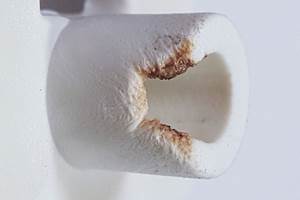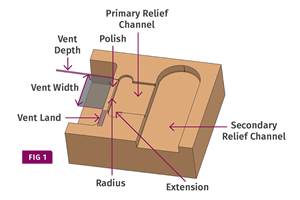What's New in Micro-Molding
Here’s a novel approach to the rapidly developing field of micro-molding. It’s a variation on two-stage injection—but with an in-line screw and plunger combination that delivers shot weights from 0.1 to 4.5 grams.
What’s New in Micro-Molding: An Injector Inside the Mold
Here’s a novel approach to the rapidly developing field of micro-molding. It’s a variation on two-stage injection—but with an in-line screw and plunger combination that delivers shot weights from 0.1 to 4.5 grams. The plasticating cylinder and plunger are joined together into one reciprocating member. The plunger is actually an extension of the injection nozzle, which extends into the mold and hot-runner system. Further, the hot-runner system is an integral part of the molding machine. In what is said to be a cost-saving arrangement, most of the runnerless hot half, the mold base, and the stationary platen are one and the same.
This patented system, called “Direct Injection Molding” or D-I-M, comes from Ettlinger Kunststoffmaschinen GmbH in Konigsbrunn, Germany. The model ET 10/16 1 is a compact system with a tiebarless, 11-ton clamp and total footprint of about 6 x 2 ft x 5 ft high. It was shown for the first time at the K’98 show in Dusseldorf.
Ettlinger launched a coinjection version at the Interplas ’99 show in the U.K in October, where D-I-M technology won the top Innovation Award for capital equipment from the Plastics Machinery Distributors Association and British Polymer Training Association.
The latest development in the D-I-M technology is a vertical press with vertical injector, measuring around 5 x 2.7 x 8.8 ft high (with mold open). It allows plenty of room for automation, so it can be integrated into assembly lines, Ettlinger says. The company delivered the first two vertical units, both for coinjection, in November to a German automotive molder as a beta test site.
Homogenous melt
D-I-M technology is designed for high-precision injection and very consistent melt quality, says Ettlinger. Melt is more consistent because the 16-mm plasticating screw does not reciprocate within the barrel, so the entire shot “sees” the same screw L/D (20:1). Unlike some conventional two-stage systems, the in-line arrangement is said to give true first-in/first-out performance without risk of melt hang-up and inconsistent residence times.
The heart of the D-I-M technology is its plunger, which is, in effect, an extended nozzle with a non-return valve on its end. The entire plasticating unit moves forward to inject melt into the cavity. Injection stroke (up to 2 in.) is measured with a linear transducer.
The plunger tip is a check valve that permits “extremely precise dosing of the smallest shot volumes with very good repeatability and minimum dwell times,” according to Ettlinger. The hollow plunger can be of 0.2, 0.3, or 0.4 in. diam. for shot capacities of 1.6, 3.0, and 4.7 cc. Injection-pressure range is 14,510 to 36,275 psi.
The shooting pot, which is located inside the platen, feeds directly into two, four, or eight valve gates of 0.02-0.06 in. diam. The valve pins (whose actuating cylinders are built into the platen) prevent any leakage of melt while the shooting pot is being filled by the screw.
Ettlinger’s D-I-M model has a touchscreen color monitor on which all barrel and mold temperatures can be set.
Price for the D-I-M system starts at around $40,000 for a one-component, horizontal model and roughly doubles with the addition of coinjection and other options.
Ettlinger’s D-I-M micromolding system does not reciprocate the screw, but rather the entire injection unit, whose nozzle extends into the platen to serve as the injection plunger.
The extended nozzle has a check valve at the tip, which prevents back flow into the cylinder. The heated shooting pot inside the platen feeds directly into valve-gate nozzles.
Ettlinger’s 11-ton press is also available in vertical and coinjection models.
The tiebarless clamp takes a maximum mold size of 128 x 90 mm.
Related Content
Process Monitoring or Production Monitoring — Why Not Both?
Molders looking to both monitor an injection molding process effectively and manage production can definitely do both with tools available today, but the question is how best to tackle these twin challenges.
Read MoreUse These 7 Parameters to Unravel the Melt Temperature Mystery
Despite its integral role in a stable process and consistent parts, true melt temperature in injection molding can be an enigma. Learning more about these seven parameters may help you solve the puzzle.
Read MoreBack to Basics on Mold Venting (Part 1)
Here’s what you need to know to improve the quality of your parts and to protect your molds.
Read MoreBack to Basics on Mold Venting (Part 2: Shape, Dimensions, Details)
Here’s how to get the most out of your stationary mold vents.
Read MoreRead Next
People 4.0 – How to Get Buy-In from Your Staff for Industry 4.0 Systems
Implementing a production monitoring system as the foundation of a ‘smart factory’ is about integrating people with new technology as much as it is about integrating machines and computers. Here are tips from a company that has gone through the process.
Read MoreLead the Conversation, Change the Conversation
Coverage of single-use plastics can be both misleading and demoralizing. Here are 10 tips for changing the perception of the plastics industry at your company and in your community.
Read More








